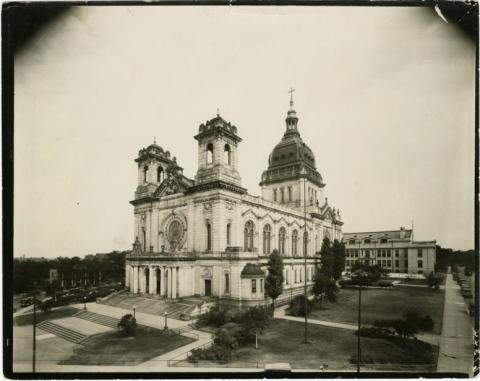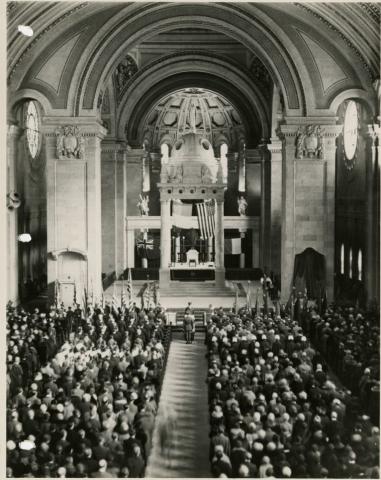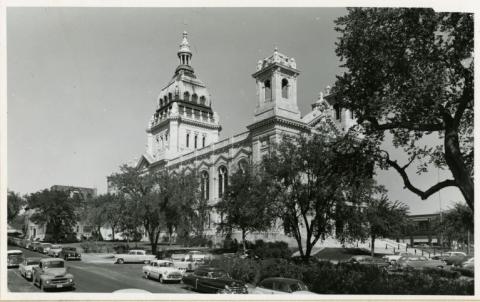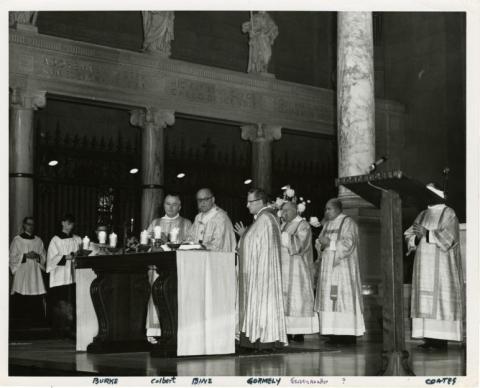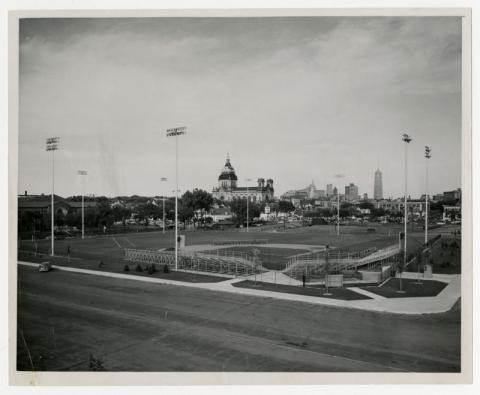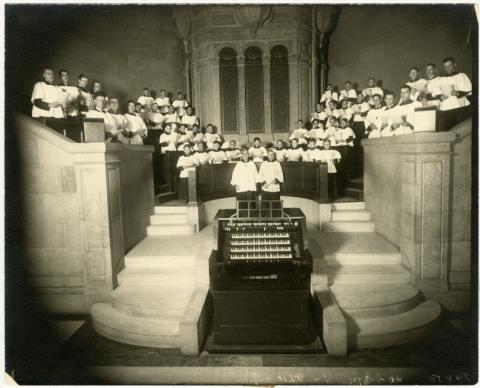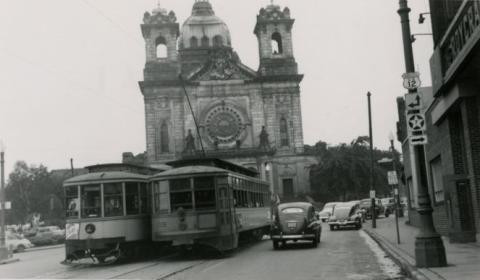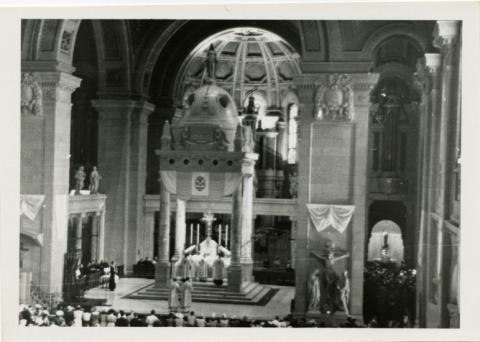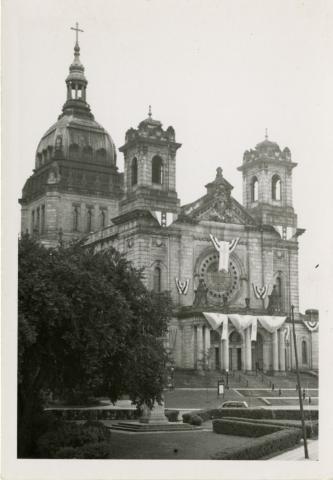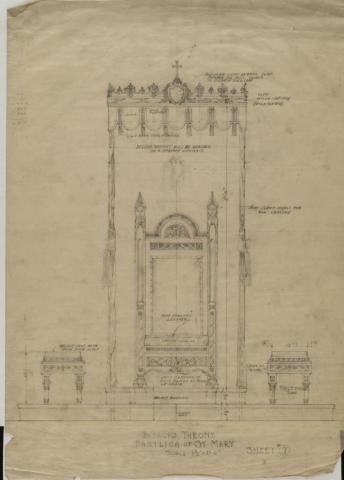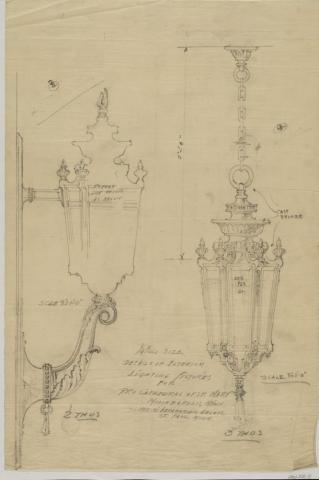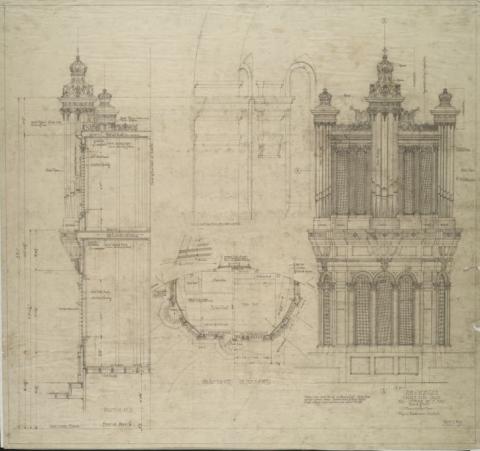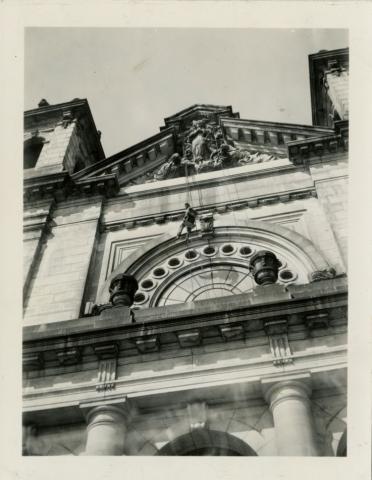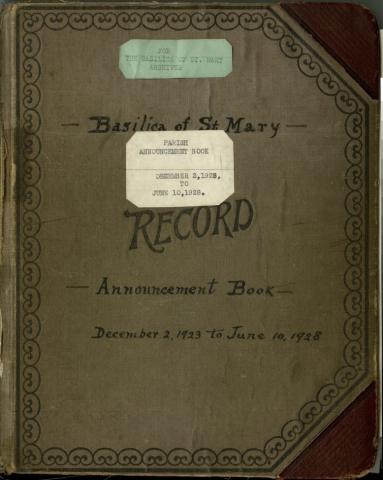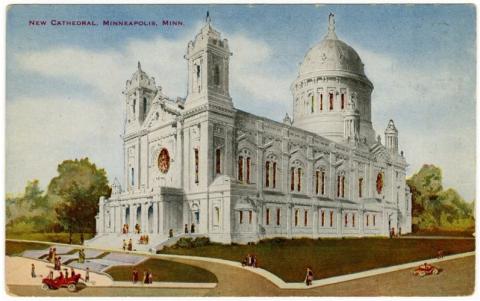Primary Source Set
by Abigail Raper, Intern, Minnesota Digital Library
Basilicas, originally a public building for markets, courthouses, and meeting halls, transformed into a church linked to a significant person or event by the 4th century. In general, basilicas are grand, rectangular structures with long halls, side aisles, and a raised platform at one or both ends. In later years, an additional aisle was added to evoke a cross. Basilicas typically have a plain exterior paired with a decorative interior. In 1926, the Basilica of Saint Mary in Minneapolis became the first basilica in America, and has remained a prominent cultural and architectural presence.
Sister to the Cathedral of Saint Paul, the Basilica of St. Mary’s originally was called the Pro-Cathedral of Minneapolis. Catholicism came to Minnesota in the late 1600’s, as French missionaries and explorers brought it to the region. The practice of Catholicism in Minnesota grew with the influx of immigrants in the 1850s, resulting in a need for bigger churches. Archbishop John Ireland was key to getting some of these churches built. He moved to America at age eleven and began studying for priesthood by age fifteen. He became the first archbishop of Saint Paul in 1888. Ireland’s vision for a wide worship space and influence led to commissioning the Twin Cities’ two major Catholic churches. Final costs were estimated to have been between 700,000 to one million dollars.
Construction on the basilica began in 1907. Both the cathedral in Saint Paul and the basilica in Minneapolis were designed and led by French architect, Emmanuel Louis Masqueray. Inspired by Renaissance and Baroque-style, he laid out a modified Greek cross for the floor plan of Saint Paul's church and a Roman cross for the Minneapolis structure. Materials such as steel and concrete, copper, marble, and stained glass were used in the construction. Despite the basilica’s first mass held in 1914, the interior would not be completed until after World War I—after the deaths of Ireland and Masqueray. During both World Wars, it supported the war effort through housing the Red Cross and women volunteers making clothes.
Although declared sacred by the National Eucharistic Congress in 1941 and added to the National Register of Historic Places in 1975, neglected maintenance led to a temporary closure in the early 1990s due to moisture damage. A block party was held in 1994, which become tradition since to raise money to fund restorations, helping encourage regular repairs. Another challenge occurred when Interstate 94 was constructed adjacent to the basilica in the 1960s. The freeway’s presence improved access but disrupted nearby residential neighborhoods while increasing noise and pollution, causing a decline in church membership. By 2000 however, membership had expanded and community engagement increased.
The basilica has been a feature of downtown Minneapolis landscape for nearly 100 years. It is one of Minnesota’s most architecturally significant churches and has added to the cultural heritage of the Twin Cities.
Discussion Questions & Activities
1) Observing the boys choir picture in the second row, what is the age range?
2) Analyzing the three sketches of the basilica, how does this assist in understanding the architecture?
3) Pick a page from the announcement book and write a paragraph reflecting on what you read. What did you learn or already know? Did it add to comprehension of the basilica? Was it challenging to understand?
4) Using your senses, describe the basilica. How do you imagine the walls feel? What would it sound like on the inside? What is the first thing you would notice while walking in? Have fun exploring what it might be or is like to visit.
5) Comparing the most recent picture to the earliest, how do you believe the surroundings changed?
6) After reading Masqueray’s biography, research another one of his works. How does it compare to his Minneapolis project?
7) Why are there changes with the church’s name? Is it important? Confusing?
8) Looking through the resources, what’s a term you’re unfamiliar with, if any? Take time to look up the word and explain how it may relate to what you’ve learned about the basilica.
9) Mentioned in the article, History, the bronze doors have symbolism. Find another material used, whether from this or another listed source, and see if it has a symbolic meaning. Why was that material used?
10) Reading through the history of basilicas from Britannica Academic, why did it transform from public to Christian activities? Did this change signal a larger historical impact?
eLibrary Minnesota Resources (for Minnesota residents)
1) "Basilica." Britannica Academic, Encyclopædia Britannica, 14 Aug. 2008. (accessed 21 June 2023).
2) Hopfensperger, Jean. “Basilica of St. Mary in Minneapolis Marks 150 Years.” Star Tribune, 8 Dec. 2018. EBSCO, Points of View Reference Center (accessed 22 June 2023).
3) Kane, Kathleen. “Gifts from the Dispossessed.” America, vol. 178, no. 8, 14 Mar. 1998, pp. 6–8. EBSCOhost (accessed 22 June 2023).
Additional Resources for Research
1) "Cathedral Fund Will Be Raised." St. Paul Globe, December 26, 1904 (accessed 21 June 2023).
2) “History: America's First Basilica.” The Basilica of Saint Mary, 2 May 2023. (accessed 15 June 2023).
3) "News of Minnesota." Warren Sheaf, April 16, 1908 (accessed 21 June 2023).
4) “Our History.” Archdiocese of Saint Paul and Minneapolis, 3 Feb. 2023. (accessed 21 June 2023).
5) “Our Mission & Vision: The Basilica of Saint Mary.” The Basilica of Saint Mary, 2 May 2023. (accessed 15 June 2023).
6) Baymiller, Joanna. “History of an Avenue.” Design Quarterly, no. 117, 1982, pp. 6–11. JSTOR. (accessed 15 June 2023).
7) Cartwright, R. L. "Basilica of St. Mary, Minneapolis." MNopedia, Minnesota Historical Society. (accessed 15 June 2023).
8) Dunn, R.C. "Pro-Cathedral Corner Stone." The Princeton Union, June 4, 1908 (accessed 21 June 2023).
9) Hoekstra, Joel. “Masqueray in Minnesota.” Architecture MN Magazine, 13 Mar. 2017. (accessed 21 June 2023).
10) Roberts, Kate. "Ireland, John (1838–1918)." MNopedia, Minnesota Historical Society. (accessed 21 June 2023).
11) Zamora, Karen. “Two Decades Later, Basilica Block Party Rocks On.” Star Tribune, 12 July 2014. (accessed 29 June 2023).
Published onLast Updated on
